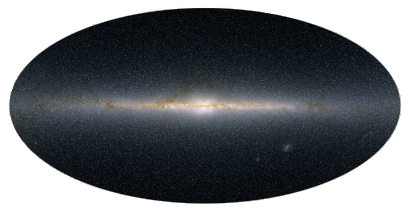Infrared
| Wavelength range | m | 10-4 - 7×10-7 |
| Frequency range | Hz | 3×1012 - 4×1014 |
| Energy range | eV | 10-2 - 2 |
 |
|
All sky map at 2×10-6 m. Our galaxy the Milky Way is seen as a clear strip across the image with the central core in the middle of the image. |
ESA Missions
ISO
ISO was a dedicated infrared observatory. It covered the spectral range of 2.5 to 240 µm and was operational from 1995 to 1998.
Herschel
Herschel studies the longer wavelength region of the infrared (called far infrared) as well as the neighbouring part of the microwave radiation which is also known as the "submillimetre".
Hubble
The Hubble Space Telescope covers the energy range 0.1 to 2.5 µm, encompassing the entire optical part of the spectrum along with parts of both the ultraviolet and the infrared.
JWST
JWST will be Hubble's successor and is planned to cover the wavelengths between 0.6 and 28 µm, which is at the high end of the optical part of the spectrum and up to the middle of the infrared part of the spectrum.
Sources of Infrared radiation include
- Interstellar medium: clouds of gas and dust at temperatures around 10-100K radiate thermal emission in the infrared.
- Planets: thermal radiation peaking in the infrared.
- Galaxies: some classes of galaxies are brighter in the infrared then at any other wavelength. They contain large amounts of gas and dust that are heated and then release their energy at infrared wavelengths.
